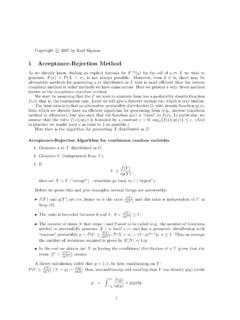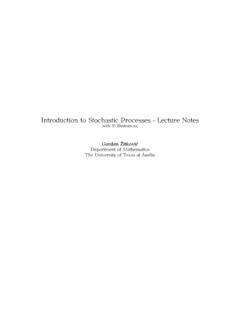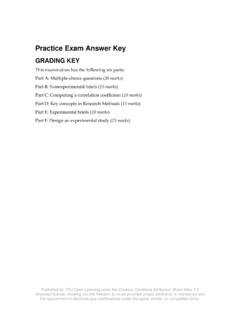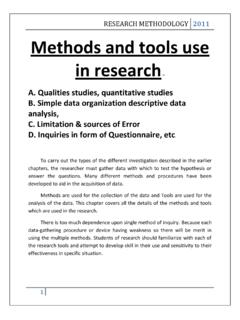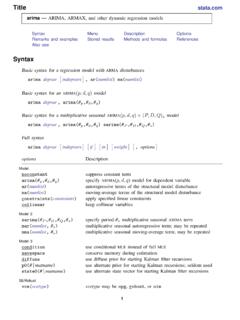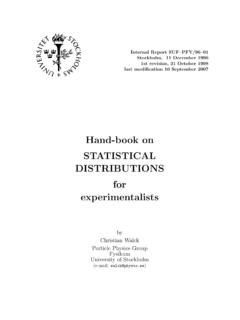Transcription of Selecting Research Participants - SAGE Publications Inc
1 125 CHAPTER 6 Selecting Research ParticipantsOBJECTIVESA fter studying this chapter, students should be able to Define the term sampling frame Describe the difference between random sampling and random assignment Define the term probability sampling Describe the difference between random , systematic, strat-ified, cluster, and multistage sampling Define the term nonprobability sampling Describe the difference between convenience, quota, and referral sampling Determine the best sampling method for a given Research problem Describe the relationship between sample size and effect size Describe the relationship between statistical power and sample sizeHave you ever received a phone call from someone who works for some Research insti-tute and wants a few minutes of your time?
2 Have you received a questionnaire in the mail or online? Anyone come to your door wanting to know what kinds of products you prefer? We certainly have. How come they picked you, you might have wondered? In this chapter, we discuss methods researchers use to select the people they want to IN PSYCHOLOGICAL RESEARCH126 Whether you are surveying people on the street or gathering Participants for an experiment, you are Selecting a sample from a population of potential Participants . Probably the only Research that is conducted on whole populations is carried out by government agencies when they conduct a census. We all know that only the government can afford to measure the entire population.
3 The rest of us conduct our Research on some sample from a population. We then use inferential statistics to make statements about the population based on the findings from our sample. One of the assumptions of inferential statistics is that the samples were randomly selected from the population. In the real world, this is almost never practiced. Indeed, most psychological Research is based on first-year university students enrolled in introductory psychology courses. We knowingly violate this assumption because we are usually not interested in describing a population. Instead, our Research goal is to test a theory. We do this by generating a testable Research hypothesis, Selecting Participants , and conducting the study.
4 Unless our theory somehow does not apply to the Participants we have selected, we should be safe in using samples that are not randomly selected. On the other hand, if our Research goal is to describe an entire population based on our sample ( , by surveying), then how we select our sample is critical. And if this is our goal, then the first step is to obtain a list of the population a sampling sampling frame is the list that is used to select from a population. For example, if you wanted to select students from a population of all the students at a university, your best sampling frame would be a list of all registered students. If you were interested in sampling from schools, then a list of all the schools in a certain district would be your sampling frame.
5 Keep in mind that a sampling frame may not be complete. For example, a telephone directory will not include households with unlisted numbers or people without phones. Also, when a sampling frame exists, its use may be restricted. For example, it may be that the registrar s office will not allow access to student information. Finally, there are many populations for which a sampling frame simply does not METHODSThe various approaches to sampling can be broken down into two groups namely, (1) probability and (2) nonprobability SamplingThese techniques are termed probability sampling techniques because you can specify the probability that a participant will be selected from a population.
6 By obtaining your sample with probability techniques, you can be reasonably confident that your sample is representative of the population. At the very least, your selection procedure could be replicated by others to obtain similar SamplingRandom sampling is a procedure whereby a sample is drawn such that each member of the population has an equal probability of being included in that sample. The probability CHAPTER 6 Selecting Research Participants127that any one individual will be included in the sample is 1 divided by the size of the population , population 1 size. If we had a small population, we could put each member s name in a hat, shake it up, and draw out the number of names we need for our sample.
7 Clearly, if our population is large, this is not going to work. Many statistics texts have a table of random numbers in the appendix. This table can be used to select the members of a sample from the population. Although few researchers use this procedure, many statistical techniques are based on the assumption that sampling has been random . As we discussed previously, this is not really a huge problem for social science researchers who are typically testing theories, not generalizing to entire populations. Our students often have difficulty distinguishing between random sampling or random selection of Participants and random assignment of Participants to groups.
8 As we just said, random sampling rarely happens in psychological Research , and this is not a huge problem, but random assignment of Participants to groups is a very common procedure and is an important assumption of several statistical procedures. random assignment means that Participants have been independently assigned to groups. Imagine that we have selected 40 Participants for a two-group experiment. We could use a table of random numbers to assign 20 Participants to the experimental group and 20 to a control group. This would be an example of random assignment of Participants to conditions. In Chapter 7, we will discuss experimental designs where random assignment will be used to create the groups in a study.
9 Figure illustrates the difference between random selection and random SamplingSuppose we have a list of all the social workers employed by our city, 600 in all. We could obtain a sample of 100 by Selecting every sixth person on the list ( , 600 divided by 100 = 6) (see Figure ). The probability that any person will be included in this sample is 1 in 6. When using systematic sampling, be sure that the organization of your list cannot bias your sample. Imagine if you were to select every second person from a list of married couples that were organized man, woman, man, woman!CONCEPTUAL EXERCISE 6AA researcher randomly selects and telephones 250 homes listed in a city phone book and conducts a is the sampling frame?
10 Stratified SamplingConsider the example above where we selected every sixth social worker on our list. Imagine we were gathering opinions about government support for social workers. We might think that social workers with different amounts of experience in the field might have different opinions about this issue. One way to get a fairer assessment of the workers METHODS IN PSYCHOLOGICAL RESEARCH128 FIGURE random Selection and random AssignmentRandom SelectionRandom AssignmentCHAPTER 6 Selecting Research Participants129opinions about this issue would be to stratify the sample by length of experience. Suppose you learn that 20% of the social workers in this population have 10 years or more of experience, 40% have 5 to 10 years, and 40% have less than 5 years of experience.











